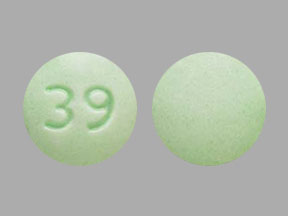Hyoscyamine Sulfate Elixir: Package Insert / Prescribing Info
Package insert / product label
Dosage form: oral elixir
Drug class: Anticholinergics / antispasmodics
Medically reviewed by Drugs.com. Last updated on Sep 30, 2024.
On This Page
Hyoscyamine Sulfate Elixir Description
Hyoscyamine Sulfate Oral Drops(Hyoscyamine Sulfate Oral Solution, USP) contains 0.125 mg hyoscyamine sulfate per mL with 5% v/v ethyl alcohol for oral administration.
Hyoscyamine Sulfate Elixir, USP(Hyoscyamine Sulfate Elixir) contains 0.125 mg hyoscyamine sulfate per 5 mL with 20% v/v ethyl alcohol for oral administration.
Hyoscyamine Sulfate Tablets, USPcontain 0.125 mg hyoscyamine sulfate formulated for oral administration.
Hyoscyamine Sulfate Sublingual Tabletscontain 0.125 mg hyoscyamine sulfate for sublingual administration. However, the tablets may be chewed or taken orally.
Hyoscyamine Sulfate Orally Disintegrating Tabletscontain 0.125 mg hyoscyamine sulfate formulated for oral administration. Hyoscyamine Sulfate Orally Disintegrating Tablets, 0.125 mg disintegrate within seconds after placement on the tongue, allowing them to be swallowed with or without water.
Hyoscyamine sulfate is one of the principal anticholinergic/antispasmodic components of belladonna alkaloids. The empirical formula is (C 17H 23NO 3) 2• H 2SO 4• 2H 2O and the molecular weight is 712.85. Chemically, it is benzeneacetic acid, (α-(hydroxymethyl)-,8-methyl-8-azabicyclo [3.2.1.] oct-3-yl ester, [3(S)-endo]-,sulfate (2:1), dihydrate with the following structure:
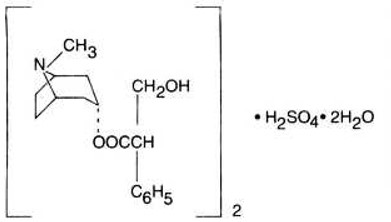
Hyoscyamine Sulfate Oral Dropsalso contain as inactive ingredients: Ethyl alcohol, citric acid, FD&C red #40, FD&C yellow #6, lemon flavor, glycerin, sodium benzoate, sodium citrate, sorbitol solution, sucrose, and water.
Hyoscyamine Sulfate Elixiralso contains as inactive ingredients: Ethyl alcohol, citric acid, FD&C red #40, FD&C yellow #6, lemon flavor, glycerin, purified water, sodium benzoate, sodium citrate, sorbitol solution, and sucrose.
Hyoscyamine Sulfate Tabletsalso contain as inactive ingredients: Colloidal silicon dioxide, crospovidone, magnesium stearate and microcrystalline cellulose.
Hyoscyamine Sulfate Sublingual Tabletsalso contain as inactive ingredients: Mannitol, sorbitol, crospovidone, artificial strawberry flavor, colloidal silicon dioxide, sodium stearyl fumarate, and magnesium stearate.
Hyoscyamine Sulfate Orally Disintegrating Tabletsalso contain as inactive ingredients: Mannitol, sorbitol, crospovidone, artificial strawberry flavor, colloidal silicon dioxide, sodium stearyl fumarate, and magnesium stearate.
Hyoscyamine Sulfate Elixir - Clinical Pharmacology
Hyoscyamine Sulfate inhibits specifically the actions of acetylcholine on structures innervated by postganglionic cholinergic nerves and on smooth muscles that respond to acetylcholine but lack cholinergic innervation. These peripheral cholinergic receptors are present in the autonomic effector cells of the smooth muscle, cardiac muscle, the sinoatrial node, the atrioventricular node, and the exocrine glands. At therapeutic doses, it is completely devoid of any action on autonomic ganglia. Hyoscyamine sulfate inhibits gastrointestinal propulsive motility and decreases gastric acid secretion. Hyoscyamine sulfate also controls excessive pharyngeal, tracheal and bronchial secretions.
Hyoscyamine sulfate is absorbed totally and completely by sublingual administration as well as oral administration. Once absorbed, hyoscyamine sulfate disappears rapidly from the blood and is distributed throughout the entire body. The half-life of hyoscyamine sulfate is 2 to 3 1/2 hours. Hyoscyamine sulfate is partly hydrolyzed to tropic acid and tropine but the majority of the drug is excreted in the urine unchanged within the first 12 hours. Only traces of this drug are found in breast milk. Hyoscyamine sulfate passes the blood brain barrier and the placental barrier. The tablets can be taken orally with the same pharmacological effects occurring; however, the effects may not occur as rapidly as with sublingual administration.
Indications and Usage for Hyoscyamine Sulfate Elixir
Hyoscyamine sulfate is effective as adjunctive therapy in the treatment of peptic ulcer. It can also be used to control gastric secretion, visceral spasm and hypermotility in spastic colitis, spastic bladder, cystitis, pylorospasm, and associated abdominal cramps. May be used in functional intestinal disorders to reduce symptoms such as those seen in mild dysenteries, diverticulitis, and acute enterocolitis. For use as adjunctive therapy in the treatment of irritable bowel syndrome (irritable colon, spastic colon, mucous colitis) and functional gastrointestinal disorders. Also used as adjunctive therapy in the treatment of neurogenic bladder and neurogenic bowel disturbances (including the splenic flexure syndrome and neurogenic colon). Also used in the treatment of infant colic (elixir and drops). Hyoscyamine sulfate is indicated along with morphine or other narcotics in symptomatic relief of biliary and renal colic; as a “drying agent” in the relief of symptoms of acute rhinitis; in the therapy of parkinsonism to reduce rigidity and tremors and to control associated sialorrhea and hyperhidrosis. May be used in the therapy of poisoning by anticholinesterase agents.
Contraindications
Glaucoma; obstructive uropathy (for example, bladder neck obstruction due to prostatic hypertrophy); obstructive disease of the gastrointestinal tract (as in achalasia, pyloroduodenal stenosis); paralytic ileus, intestinal atony of elderly or debilitated patients; unstable cardiovascular status in acute hemorrhage; severe ulcerative colitis; toxic megacolon complicating ulcerative colitis; myasthenia gravis.
Warnings
In the presence of high environmental temperature, heat prostration can occur with drug use (fever and heat stroke due to decreased sweating). Diarrhea may be an early symptom of incomplete intestinal obstruction, especially in patients with ileostomy or colostomy. In this instance, treatment with this drug would be inappropriate and possibly harmful. Like other anticholinergic agents, Hyoscyamine sulfate may produce drowsiness, dizziness or blurred vision. In this event, the patient should be warned not to engage in activities requiring mental alertness such as operating a motor vehicle or other machinery or to perform hazardous work while taking this drug.
Psychosis has been reported in sensitive individuals given anticholinergic drugs including hyoscyamine sulfate. CNS signs and symptoms include confusion, disorientation, short term memory loss, hallucinations, dysarthria, ataxia, coma, euphoria, decreased anxiety, fatigue, insomnia, agitation and mannerisms, and inappropriate affect. These CNS signs and symptoms usually resolve within 12 to 48 hours after discontinuation of the drug.
Precautions
General:
Use with caution in patients with: autonomic neuropathy, hyperthyroidism, coronary heart disease, congestive heart failure, cardiac arrythmias, hypertension, and renal disease. Investigate any tachycardia before giving any anticholinergic drug since they may increase the heart rate. Use with caution in patients with hiatal hernia associated with reflux esophagitis.
Information for Patients:
Like other anticholinergic agents, hyoscyamine sulfate may produce drowsiness, dizziness or blurred vision. In this event, the patient should be warned not to engage in activities requiring mental alertness such as operating a motor vehicle or other machinery or to perform hazardous work while taking this drug.
Use of hyoscyamine sulfate may decrease sweating resulting in heat prostration, fever or heat stroke; febrile patients or those who may be exposed to elevated environmental temperatures should use caution.
Drug Interactions:
Additive adverse effects resulting from cholinergic blockade may occur when hyoscyamine sulfate is administered concomitantly with other antimuscarinics, amantadine, haloperidol, phenothiazines, monoamine oxidase (MAO) inhibitors, tricyclic antidepressants or some antihistamines.
Antacids may interfere with the absorption of hyoscyamine sulfate. Administer hyoscyamine sulfate before meals; antacids after meals.
Carcinogenesis, Mutagenesis, Impairment of Fertility:
No long-term studies in animals have been performed to determine the carcinogenic, mutagenic or impairment of fertility potential of hyoscyamine sulfate; however, years of marketing experience with hyoscyamine sulfate shows no demonstrable evidence of a problem.
Pregnancy - Pregnancy Category C:
Animal reproduction studies have not been conducted with hyoscyamine sulfate. It is also not known whether hyoscyamine sulfate can cause fetal harm when administered to a pregnant woman or can affect reproduction capacity. Hyoscyamine sulfate should be given to a pregnant woman only if clearly needed.
Nursing Mothers:
Hyoscyamine sulfate is excreted in human milk. Caution should be exercised when hyoscyamine sulfate is administered to a nursing woman.
Geriatric Use:
Reported clinical experience has not identified differences in safety between patients aged 65 and over and younger patients. In general, dose selection for an elderly patient should be cautious, usually starting at the low end of the dosing range, reflecting the greater frequency of decreased hepatic, renal, or cardiac function, and of concomitant disease or other drug therapy.
This drug is known to be substantially excreted by the kidney, and the risk of toxic reactions to this drug may be greater in patients with impaired renal function. Because elderly patients are more likely to have decreased renal function, care should be taken in dose selection, and it may be useful to monitor renal function.
Adverse Reactions/Side Effects
The following adverse reactions have been reported with hyoscyamine sulfate and for pharmacologically similar drugs with anticholinergic/antispasmodic action. Adverse reactions may include dryness of the mouth; urinary hesitancy and retention; blurred vision; tachycardia; palpitations; mydriasis; increased ocular tension; loss of taste; headache; nervousness; drowsiness; weakness; fatigue; dizziness; insomnia; nausea; vomiting; impotence; constipation; bloated feeling; abdominal pain; diarrhea; allergic reactions or drug idiosyncrasies; urticaria and other dermal manifestations; ataxia; speech disturbance; some degree of mental confusion and/or excitement (especially in elderly persons); short-term memory loss; hallucinations; and decreased sweating.
Related/similar drugs
Overdosage
The signs and symptoms of overdose are headache, nausea, vomiting, blurred vision, dilated pupils, hot dry skin, dizziness, dryness of the mouth, difficulty in swallowing, and CNS stimulation.
Measures to be taken are immediate lavage of the stomach and injection of physostigmine 0.5 to 2 mg intravenously and repeated as necessary up to a total of 5 mg. Fever may be treated symptomatically (tepid water sponge baths, hypothermic blanket). Excitement to a degree which demands attention may be managed with sodium thiopental 2% solution given slowly intravenously or chloral hydrate (100-200 mL of a 2% solution) by rectal infusion. In the event of progression of the curare-like effect to paralysis of the respiratory muscles, artificial respiration should be instituted and maintained until effective respiratory action returns.
In rats, the LD 50for hyoscyamine is 375 mg/kg. Hyoscyamine sulfate is dialyzable.
Hyoscyamine Sulfate Elixir Dosage and Administration
Hyoscyamine Sulfate Oral Drops
(Hyoscyamine Sulfate Oral Solution, USP)
Dosage may be adjusted according to the conditions and severity of symptoms. Measure dosage very carefully.
Adults and pediatric patients 12 years of age and older: 1 to 2 mL every four hours or as needed. Do not exceed 12 mL in 24 hours.
Pediatric patients 2 to under 12 years of age: 1/4 to 1 mL every four hours or as needed. Do not exceed 6 mL in 24 hours.
Pediatric patients under 2 years of age: The following dosage guide is based upon body weight. The doses may be repeated every four hours or as needed.
| Body Weight | Usual Dose | Do Not Exceed In 24 Hours |
| 3.4 kg (7.5 lb.) | 4 drops | 24 drops |
| 5 kg (11 lb.) | 5 drops | 30 drops |
| 7 kg (15 lb.) | 6 drops | 36 drops |
| 10 kg (22 lb.) | 8 drops | 48 drops |
Use a dropper having markings of 3, 4, 5 DROPS, and 0.25 mL. The approximate equivalent amount of hyoscyamine sulfate drops (mL) and its equivalent amount of hyoscyamine sulfate (mg) for each marking are as follows:
| Approximate Equivalent Amount | ||
| Marking on Dropper | Hyoscyamine Sulfate Oral
Drops Solution (mL) | Hyoscyamine Sulfate (mg) |
| 3 DROPS | 0.08 mL | 0.01 mg |
| 4 DROPS | 0.11 mL | 0.01375 mg |
| 5 DROPS | 0.14 mL | 0.0175 mg |
| 0.25 mL | 0.25 mL | 0.03125 mg |
Hyoscyamine Sulfate Elixir
Dosage may be adjusted according to the conditions and severity of symptoms. Measure dosage very carefully.
Adults and pediatric patients 12 years of age and older: 1 to 2 teaspoonfuls every four hours or as needed. Do not exceed 12 teaspoonfuls in 24 hours.
Pediatric patients 2 to under 12 years of age: Please see the following dosage guide is based on body weight. The doses may be repeated every four hours or as needed. Do not exceed 6 teaspoonfuls in 24 hours.
| Body Weight | Usual Dose |
| 10 kg (22 lb.) | 1/4 teaspoon (1.25 mL) |
| 20 kg (44 lb.) | 1/2 teaspoonful (2.5 mL) |
| 40 kg (88 lb.) | 3/4 teaspoonful (3.75 mL) |
| 50 kg (110 lb.) | 1 teaspoonful (5 mL) |
Hyoscyamine Sulfate Tablets, 0.125 mg
Hyoscyamine Sulfate Sublingual Tablets, 0.125 mg
Hyoscyamine Sulfate Orally Disintegrating Tablets, 0.125 mg
Dosage may be adjusted according to the conditions and severity of symptoms. The sublingual tablets may be taken sublingually, orally or chewed.
Adults and pediatric patients 12 years of age and older:1 to 2 tablets every four hours or as needed. Do not exceed 12 tablets in 24 hours.
Pediatric patients 2 to under 12 years of age:1/2 to 1 tablet every four hours or as needed. Do not exceed 6 tablets in 24 hours.
How is Hyoscyamine Sulfate Elixir supplied
Hyoscyamine Sulfate Oral Drops (hyoscyamine sulfate oral solution, USP)(Hyoscyamine Sulfate 0.125 mg per mL) is orange colored, lemon flavored, and contains 5% ethyl alcohol. It is supplied in a 20 mL bottle (NDC 62135-513-52).
Hyoscyamine Sulfate Elixir, USP(Hyoscyamine Sulfate 0.125 mg per 5 mL) is orange colored, lemon flavored, and contains 20% ethyl alcohol. It is supplied in a pint (473 mL) bottle (NDC 62135-511-47).
Hyoscyamine Sulfate Tablets, USP, 0.125 mg are white to off -white, round tablets debossed with “ CE” on one side and “ 116” on the other.
Bottles of 120 (NDC 62135-512-12)
Hyoscyamine Sulfate Sublingual Tablets,0.125 mg are white to off-white, round, flat-faced, beveled edge, strawberry flavored tablets, debossed with “ CE” on one side and “ 222” on the other side
Bottles of 120 (NDC 62135-859-12)
Hyoscyamine Sulfate Orally Disintegrating Tablets,0.125 mg are white to off-white, round, flat-faced, beveled edge, strawberry flavored tablets, debossed with “ CE” on one side and “ 221” on the other side.
Bottles of 120 (NDC 62135-858-12)
Store at 20°-25°C (68°-77°F); excursions permitted between 15°-30°C (59°-86°F) [See USP Controlled Room Temperature].
Dispense in tight, light-resistant containers as defined in USP/NF.
Rx only.
Manufactured for:
Chartwell RX, LLC.
Congers, NY 10920
Rev. 09/2024
L70981
PRINCIPAL DISPLAY PANEL
Hyoscyamine Sulfate Elixir, USP (0.125 mg/ 5 mL) - NDC 62135-511-47- 473mL label
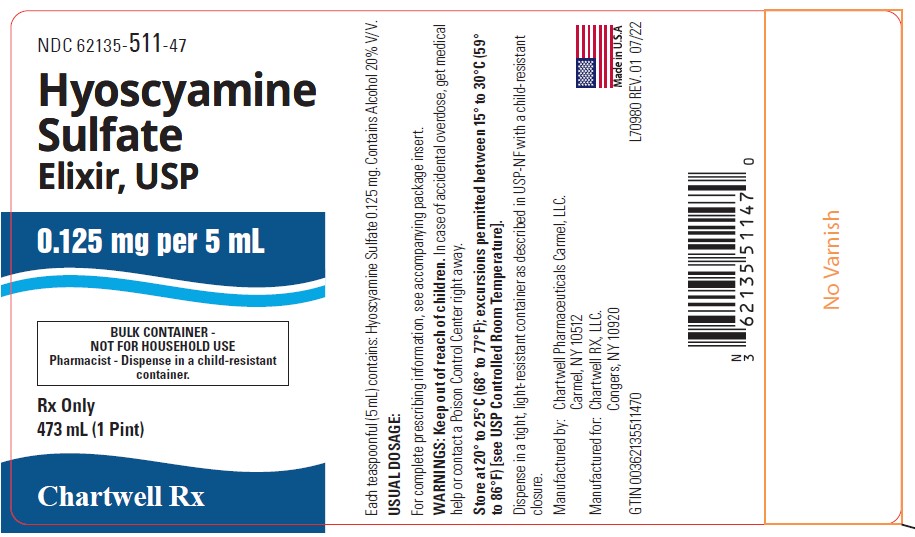
Hyoscyamine Sulfate Oral Solution, USP (0.125 mg/ 1 mL) - NDC 62135-513-52- 20mL label
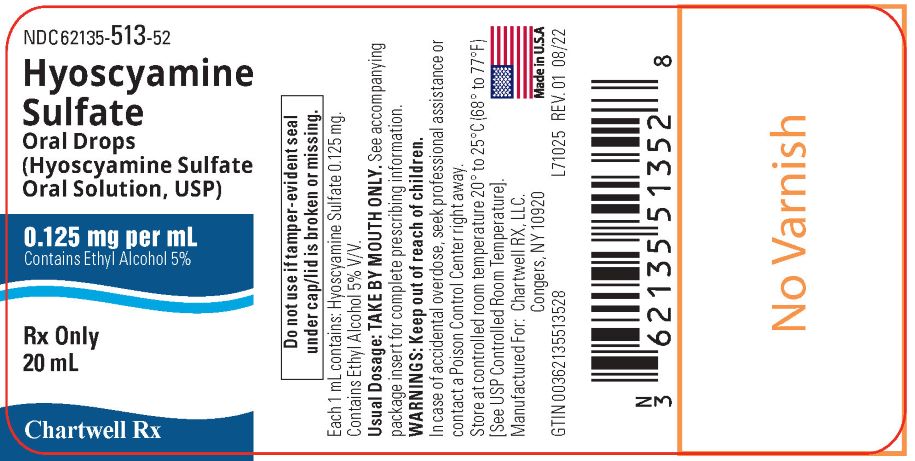
Hyoscyamine Sulfate Tablets, USP - 0.125 mg- NDC 62135-512-12- 120s-Bottle-label
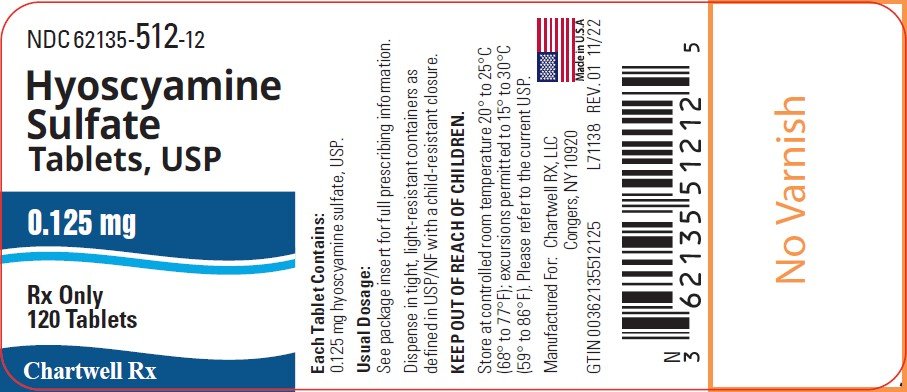
Hyoscyamine Sulfate Orally Disintegrating Tablets 0.125 mg - NDC 62135-858-12 - 120s Bottle Label
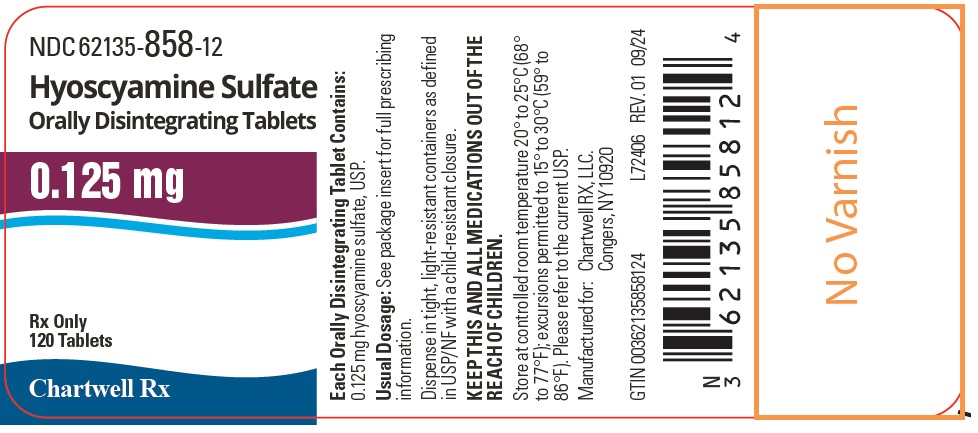
Hyoscyamine Sulfate Sublingual Tablets 0.125 mg - NDC 62135-859-12 - 120s Bottle Label
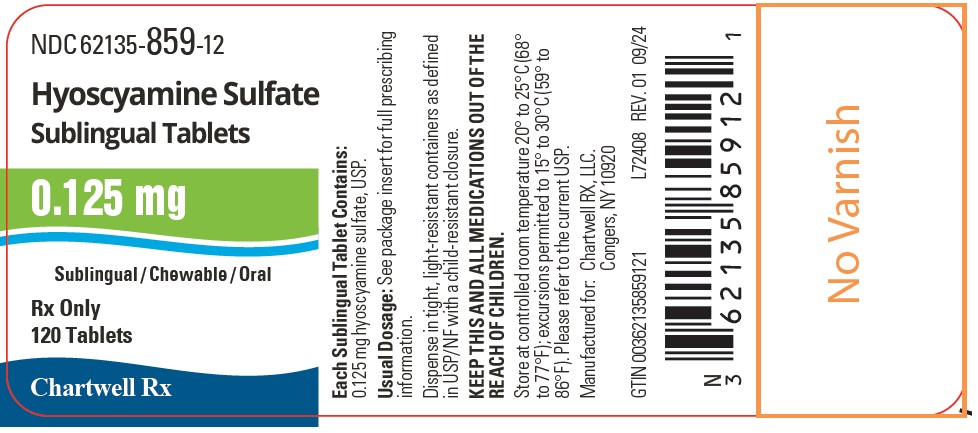
| HYOSCYAMINE SULFATE
hyoscyamine sulfate elixir |
||||||||||||||||||||||||||
|
||||||||||||||||||||||||||
|
||||||||||||||||||||||||||
|
||||||||||||||||||||||||||
|
||||||||||||||||||||||||||
|
||||||||||||||||||||||||||
|
||||||||||||||||||||||||||
| HYOSCYAMINE SULFATE
hyoscyamine sulfate solution |
||||||||||||||||||||||||||
|
||||||||||||||||||||||||||
|
||||||||||||||||||||||||||
|
||||||||||||||||||||||||||
|
||||||||||||||||||||||||||
|
||||||||||||||||||||||||||
|
||||||||||||||||||||||||||
| HYOSCYAMINE SULFATE
hyoscyamine sulfate tablet |
||||||||||||||||||
|
||||||||||||||||||
|
||||||||||||||||||
|
||||||||||||||||||
|
||||||||||||||||||
|
||||||||||||||||||
|
||||||||||||||||||
| HYOSCYAMINE SULFATE
hyoscyamine sulfate tablet, orally disintegrating |
||||||||||||||||||
|
||||||||||||||||||
|
||||||||||||||||||
|
||||||||||||||||||
|
||||||||||||||||||
|
||||||||||||||||||
|
||||||||||||||||||
| HYOSCYAMINE SULFATE SUBLINGUAL
hyoscyamine sulfate tablet |
||||||||||||||||||
|
||||||||||||||||||
|
||||||||||||||||||
|
||||||||||||||||||
|
||||||||||||||||||
|
||||||||||||||||||
|
||||||||||||||||||
| Labeler - Chartwell RX, LLC (079394054) |
| Establishment | |||
| Name | Address | ID/FEI | Business Operations |
|---|---|---|---|
| Chartwell Pharmaceuticals Congers, LLC | 118673447 | manufacture(62135-511, 62135-513, 62135-512, 62135-858, 62135-859) , analysis(62135-511, 62135-513, 62135-512, 62135-858, 62135-859) , label(62135-511, 62135-513, 62135-512, 62135-858, 62135-859) , pack(62135-511, 62135-513, 62135-512, 62135-858, 62135-859) | |
More about hyoscyamine
- Check interactions
- Compare alternatives
- Pricing & coupons
- Reviews (117)
- Drug images
- Side effects
- Dosage information
- Patient tips
- During pregnancy
- Drug class: anticholinergics/antispasmodics
- En español
Patient resources
Professional resources
- Hyoscyamine monograph
- Hyoscyamine Sulfate Extended-Release Tablets (FDA)
- Hyoscyamine Sulfate Injection (FDA)
- Hyoscyamine Sulfate Oral Drops (FDA)
- Hyoscyamine Sulfate Orally Disintegrating Tablet (FDA)
Other brands
Levsin, Hyosyne, Levsin SL, Levbid, ... +6 more

